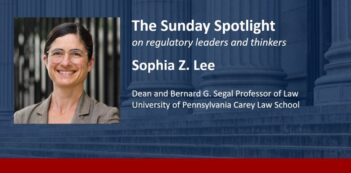
Senate bill could shake up administrative law in theory if not in practice.
A Senate bill introduced in August could reshape U.S. administrative law, further burdening an already sluggish rulemaking process but perhaps paving the way for more coordinated and streamlined federal policies, according to the Congressional Research Service (CRS).
The bill, known as the Independent Regulatory Agency Analysis Act of 2012, would authorize the president to issue an executive order requiring independent regulatory agencies to submit significant proposed rules to the White House’s Office of Management and Budget (OMB) for review and approval.
Opponents of the bill, including the heads of independent agencies such as Federal Reserve and the Securities Exchange Commission, argue that extending presidential review would “interfere” with these agencies’ autonomous functions.
A centralized review requirement of this sort currently exists for rulemaking by executive agencies, that is, those under more direct presidential control such as the Treasury Department. President Reagan first imposed regulatory planning and review standards on executive agencies by requiring them to submit proposed and final rules for White House review. President Clinton issued an executive order, subsequently retained by the Bush and Obama administrations, that revised these review standards but maintained centralized review requirements for executive agencies.
Executive oversight over rulemaking ostensibly aims to ensure consistency with executive polices and congressional directives. Presidential review of the rulemaking activities of independent agencies may reap similar benefits. Moreover, under the proposed Senate bill, these independent agencies could be ordered to engage in additional planning and review before creating new regulations, for instance by identifying a rule’s intended target problem, its relative costs and benefits, and potential alternatives.
A debate has simmered for years concerning the constitutional basis for White House oversight of federal rulemaking. At least one federal circuit court has claimed that such review presents “difficult constitutional questions concerning the executive’s proper role in administrative proceedings.” One scholar has gone so far as to argue that the executive’s unilateral impositions on agency action run afoul of the separation of powers doctrine because while presidential appointees often lead administrative agencies, these agencies derive their rulemaking authority from Congress’s delegation of its legislative powers.
In the past, presidents have considered extending review requirements to independent agencies, but political considerations precluded any final action in this direction, according to the Congressional Research Service.
Previously, three competing justifications have been offered for presidential oversight over executive agencies.
- Article 2 of the Constitution empowers the president to oversee and manage agency action to “take care that the laws be faithfully executed” (the “unitary executive theory”)
- Congress implicitly authorizes this oversight when it delegates power to an executive agency rather than an independent agency (a theory popularized by Supreme Court Justice Elena Kagan)
- The president’s breadth of control over agency action depends on whether Congress has authorized such control, remained silent but left open the possibility of concurrent authority between itself and the president, or indicated that such control is “incompatible” with congressional intent (the multi-pronged Youngstown approach).
Ultimately, each of these theories poses the question of whether the executive has inherent constitutional authority to supervise administrative agencies, or whether the president is only empowered to intervene in agency action when acting as an authorized agent of Congress.
Seizing on the unitary executive theory, the CRS report suggests that presidents may already possess the power to extend rulemaking oversight to all agencies to “ensure faithful execution of the law.” Statutory limits on “at will” versus “for cause” termination, a key distinction between executive and independent agencies, does not restrict the president’s constitutional authority to oversee rulemaking. Congress could also set additional review standards, either by empowering the executive to extend Clinton’s executive order, as proposed in the current Senate bill, or by imposing review requirements directly on independent agencies, as it has done in the past to select agencies.
Interest in regulatory efficiency, however, may caution Congress against extending such review to independent agencies. The CRS report observes that when new review requirements have been imposed on administrative agencies in the past, judicial review of those agencies for failing to comply with statutory obligations or for being arbitrary and capricious under the APA became more prevalent. However, the current Senate bill would specifically preclude judicial enforcement of any White House review requirements imposed on independent agencies.
Even if the proposed Senate bill becomes law, it may never have a discernible impact on independent agency action, the CRS report predicts. Presumably, the president will continue to lack “at will” removal power over independent agencies. That power is currently the only practical enforcement mechanism to ensure agencies comply with executive oversight, according to CRS. Without “at will” removal power, the president would be essentially powerless to sanction an independent agency which ignored the review requirements envisioned in the proposed bill.
The president would have power only if an agency’s failure to comply with executive review could be considered sufficient “cause” for terminating the head of an independent agency. However, according to the CRS report, Congress has previously rejected this interpretation, defining grounds for removal with cause only for administrators’ misconduct and improprieties, not merely political differences between administrators and the president.
It is possible, of course, that the current Senate bill could be read to alter the grounds of “for cause” removal, assuming that the bill’s provision empowering the president to require independent regulatory agencies to comply “with regulatory analysis requirements” is intended to have some practical effect. Independent agencies and executive agencies would still differ as the former would remain insulated from arbitrary or politically based termination. Nonetheless, the bill may be interpreted to carve out failure to comply with explicit presidential directives on regulatory review as a “cause” for removal.
The questions raised by the current Senate bill may ultimately prove academic. At present, it is difficult to see how the bill will move towards adoption in the near future. However, if its supporters were to succeed in seeing it passed and signed by a president, it will undoubtedly renew an ongoing constitutional debate within the field of administrative law.



